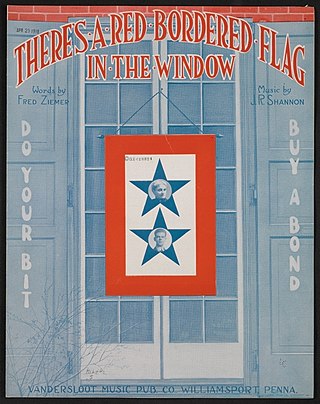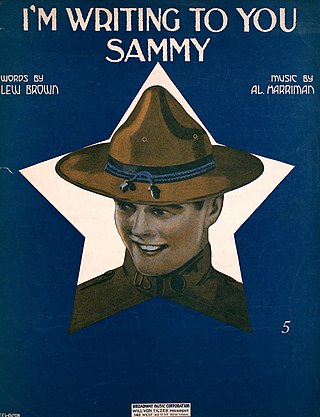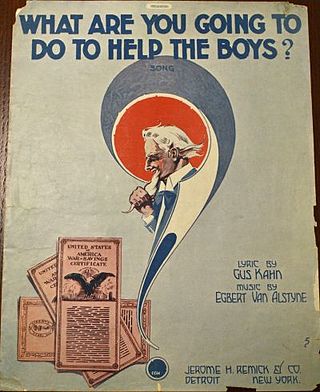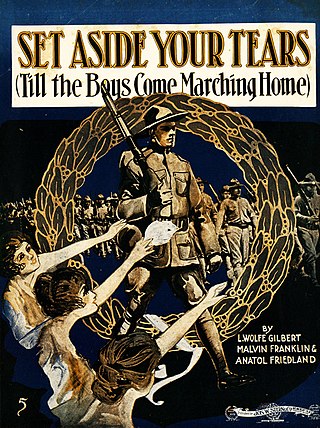
Smiling Sammy: Fox Trot is a World War I era song released in 1917. The music was written by Arthur M. Kraus. The song was published by Jerome H. Remick & Co. in Detroit, Michigan. On the cover of the sheet music, there is a soldier marching with a gun resting on his shoulder. The cover artist is Tony Sarg. The song was written for piano.

There's a Red-Bordered Flag in the Window is a World War I era song released in 1918. Fred Ziemer wrote the lyrics. J.R. Shannon composed the music. The song was published by Vandersloot Music Publishing Company of Williamsport, Pennsylvania. On the cover, there is a red-bordered service flag with two blue stars. It hangs in front of a window. On each of the two stars is a picture of a mother and her son. The piece was written for both voice and piano. The song is directed at a mother of a soldier. It begins with, "Why are you sad little mother? Why do your eyes fill with tears?" Later the narrator encourages the mother to keep hope. The flag is seen as a symbol of pride and love, as evidenced by the chorus:

"What Kind of an American Are You?", also known as "What Kind of American Are You?", is a World War I era song released in 1917. Albert Von Tilzer composed the music. Lew Brown and Charles R. McCarron wrote the lyrics. The song was published by Broadway Music Co. of New York, New York. On the cover is a gray drawing of Uncle Sam pointing. A map of the United States is featured on the lower half of the cover. The song was written for voice and piano.

I'm Writing to You, Sammy is a World War I era song released in 1917. Lew Brown wrote the lyrics. Al Harriman composed the music. The song was published by Broadway Music Company of New York, New York. On the cover of the sheet music is a drawing of a soldier, from the shoulders up, inside of a star. Artist E.E. Walton designed the cover. The song was written for both piano and voice.

Uncle Sammy, Take Care of My Girl is a World War I song released in 1918. Betty Morgan wrote the lyrics. Jimmie Morgan composed the music. The song was published by F.J.A. Forster of Chicago. On the cover of the sheet music is a soldier in a trench, writing a letter. The smoke of the fire has a drawing of Uncle Sam reading the letter to a woman. There is also a photo of the lyricist and composer. Artist Dan Sweeney designed the cover. Another version of the cover shows a soldier in the upper right-hand side, writing a letter. In the lower left corner, Uncle Sam offers the letter to a woman. A photo of the lyricist and composer are also featured on the cover. It was written for both voice and piano.

"What Are You Going to Do to Help the Boys?" is a World War I era song released in 1918. Gus Kahn wrote the lyrics. Egbert Van Alstyne composed the music. It was published by Jerome H. Remick & Co. of Detroit, Michigan. Artist E.E. Walton designed the sheet music cover. It features Uncle Sam inside a red, white, and blue question mark. He is holding his beard and looking down at liberty bonds. To the left of this image it reads, "Buy a Liberty Bond!" on some editions. The song was written for both piano and voice.

"Bring Back My Daddy To Me" is a World War I era song released in 1917. William Tracey and Howard Johnson wrote the lyrics. George W. Meyer composed the music. Leo Feist, Inc. of New York, New York published the song.

"And He'd Say, 'Oo-La-La! Wee-Wee!'" is a World War I era song released in 1919. Lyrics and music were written by George Jessel and Harry Ruby. William Baker arranged the song. It was published by Waterson, Berlin & Snyder, Inc. of New York, New York. The song was written for voice and piano.

"Girls of France" is a World War I era song released in 1917. Al Bryan and Edgar Leslie wrote the lyrics. Harry Ruby composed the music. The song was published by Waterson, Berlin & Snyder Co. of New York, New York. Artist Albert Wilfred Barbelle designed the sheet music cover. It features a nurse in the foreground, and soldiers marching behind her. It was written for both voice and piano.

"For Your Country and My Country" is a World War I era song released in 1917. Lyrics and music were written by Irving Berlin. The song was published by Waterson, Berlin & Snyder, Co. of New York, New York. Artist Albert Wilfred Barbelle designed the sheet music cover. It features Uncle Sam playing a snare drum with an eagle on his shoulder. In the background are ships sailing, and below are troops marching. Above the title, it reads, "The Official Recruiting Song." The song was written for voice and piano, along with chords for guitar, ukulele, and banjo.

When the Clouds of War Roll By is a World War I song composed by Earl Haubrich with lyrics by Nat Binns. It was published in 1917 by Ted Browne Music Co. in Chicago, Illinois.
"Hock The Kaiser!" is a World War I song written and composed by James H. Hall in 1917. It targets the German emperor Wilhelm II of Germany. The work was self-published by James H. Hall in Chicago, Illinois.

"I'm Giving You To Uncle Sam" is a World War I song written by Thomas H. Ince and composed by Victor Schertzinger. The song was published in 1918 by Southern California Music in Los Angeles, CA. The sheet music cover depicts soldiers charging out of a trench with the US Capitol and a flag in the background.

"America's the Word for You and Me" is a World War I song written composed by Jacob J. Tanner Jr. The song was published in 1918 by Jacob J. Tanner Jr., in Pittsburgh, Pennsylvania. The sheet music cover depicts a photo of President Wilson and the head of Uncle Sam with an inset of George Washington.

"If I Had a Son for Each Star in Old Glory " is a World War I song written by James E. Dempsey and composed by Joseph A. Burke. This song was published in 1917 by Leo Feist, Inc., in New York City. The sheet music cover, illustrated by Rosenbaum Studios, features a mother looking at a picture of her son with an inset photo of Monte Austin. Other editions feature Brice and King; Buddy Clark; Ben Davis; and Florence Timponi.

"Mother, Here's Your Boy!" is a World War I song written and composed by Sidney D. Mitchell, Archie Gottler, and Theodore Morse. This song was published in 1918 by Leo. Feist, Inc., in New York, NY. The sheet music cover depicts Uncle Sam presenting a returning soldier to his mother with the Statue of Liberty and ships in the background.

Set Aside Your Tears (Till the Boys Come Marching Home) is a World War I song written and composed by Wolfe Gilbert, Malvin Franklin, and Anatole Friedland. The song was first published in 1917 by Jos. W. Stern & Co. in New York, NY. The sheet music cover depicts a woman waving to marching troops.

Watch, Hope and Wait Little Girl: I'm Coming Back To You is a World War I song written by Lew Brown, and composed by Will Clayton. The song was first published in 1918 by Broadway Music Co. in New York, NY. The sheet music cover was designed by E.E. Walton, and features a young woman in a heart of red, white, and blue, flowers are gathered at her knees

Let's All Be Americans Now is a World War I song written and composed by Irving Berlin, Edgar Leslie, and George W. Meyer. The song was first published in 1917 by Waterson, Berlin & Snyder Co., in New York, NY.The sheet music cover depicts a soldier with his rifle and silhouetted marching soldiers in the background. A popular recording in 1917 was made by the American Quartet.
Uncle Sam and His Battering Ram is a World War I song written by Robert P. Hall and composed by Ida K. Mervine. The song was first published in 1918 by Mervine & Hall Music in Phoenix, AZ. The sheet music cover features Uncle Sam pointing to the Kaiser as a ram butts him in the stomach.


















